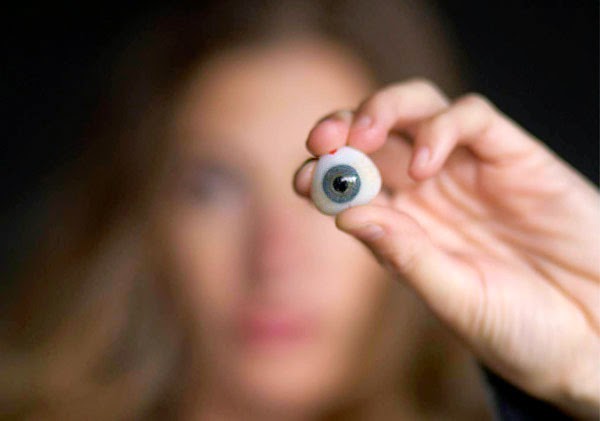Facial Prosthesis
Researchers have developed a fast and inexpensive way to make facial prostheses for eye cancer patients using facial scanning software and 3-D printing, according to findings released at AAO 2014, the 118th annual meeting of the American Academy of #Ophthalmology. Their novel process can create more affordable prosthetics for any patients who have hollow sockets resulting from eye surgery following cancer or congenital deformities.
In the United States, more than 2,700 new cases of eye cancer are diagnosed each year, according to the American Cancer Society, and the mortality rate is high for the disease. Some patients undergo a life-saving surgery known as exenteration that involves removing the contents of the eye socket and other tissue. The research team hopes to bring these patients relief by providing a more affordable facial prosthesis that will allow them to live their lives more fully and with less stigma.
Conventional facial prostheses can cost $10,000 to $15,000 and take weeks to produce.
University of Miami researchers developed a process to manufacture facial prostheses in a matter of hours at a fraction of the cost of a traditional prosthesis using topographical scanning and 3-D printing technology. Patients are scanned on the undamaged side of their face using a mobile scanner. The software then creates a mirror image. Along with a scan of the side of the face with the orbital defect, the program can mesh the two scans together to create a 3-D image of the face. The topographical information then goes to a 3-D printer, which translates the data into a mask formed out of injection-molded rubber suffused with colored pigments matching the patient's skin tone.
The project started as the brainchild of David Tse, M.D., professor of ophthalmology at the Bascom Palmer Eye Institute in Florida and the Nasser Ibrahim Al-Rashid chair in ophthalmic plastic, orbital surgery and oncology. Dr. Tse was treating a child with eye cancer who had both eyelids removed and underwent exenteration. The family could not afford an ocularist, so Dr. Tse raised donations to help pay for her first prosthesis. Now a teenager, she has grown out of the prosthesis and must instead wear an eye patch.
Designed and developed in partnership with Dr. Tse and a team at the Composite Materials Lab at the University of Miami, the 3-D printed prosthesis possesses several advantages over the conventional type created by an ocularist. The material involves a proprietary mix of nanoparticles that provides extra reinforcement and makes it possible to match many shades of skin. Over time, conventional facial prostheses can discolor and fray at the edges, but nanoclay protects the material from breaking down and changing color when exposed to moisture and light. It also prevents dirt from depositing. If the prosthesis ever needs to be replaced, reproduction can happen with the press of a button.
Rapid and cost-effective orbital prosthesis fabrication via automated non-contact facial topography mapping and 3-D printing (PO467) was presented at AAO 2014, the 118th annual meeting of the American Academy of Ophthalmology in conjunction with the European Society of Ophthalmology, which is in session October 18-21 at McCormick Place in Chicago.
In the United States, more than 2,700 new cases of eye cancer are diagnosed each year, according to the American Cancer Society, and the mortality rate is high for the disease. Some patients undergo a life-saving surgery known as exenteration that involves removing the contents of the eye socket and other tissue. The research team hopes to bring these patients relief by providing a more affordable facial prosthesis that will allow them to live their lives more fully and with less stigma.
Conventional facial prostheses can cost $10,000 to $15,000 and take weeks to produce.
University of Miami researchers developed a process to manufacture facial prostheses in a matter of hours at a fraction of the cost of a traditional prosthesis using topographical scanning and 3-D printing technology. Patients are scanned on the undamaged side of their face using a mobile scanner. The software then creates a mirror image. Along with a scan of the side of the face with the orbital defect, the program can mesh the two scans together to create a 3-D image of the face. The topographical information then goes to a 3-D printer, which translates the data into a mask formed out of injection-molded rubber suffused with colored pigments matching the patient's skin tone.
The project started as the brainchild of David Tse, M.D., professor of ophthalmology at the Bascom Palmer Eye Institute in Florida and the Nasser Ibrahim Al-Rashid chair in ophthalmic plastic, orbital surgery and oncology. Dr. Tse was treating a child with eye cancer who had both eyelids removed and underwent exenteration. The family could not afford an ocularist, so Dr. Tse raised donations to help pay for her first prosthesis. Now a teenager, she has grown out of the prosthesis and must instead wear an eye patch.
Designed and developed in partnership with Dr. Tse and a team at the Composite Materials Lab at the University of Miami, the 3-D printed prosthesis possesses several advantages over the conventional type created by an ocularist. The material involves a proprietary mix of nanoparticles that provides extra reinforcement and makes it possible to match many shades of skin. Over time, conventional facial prostheses can discolor and fray at the edges, but nanoclay protects the material from breaking down and changing color when exposed to moisture and light. It also prevents dirt from depositing. If the prosthesis ever needs to be replaced, reproduction can happen with the press of a button.
Rapid and cost-effective orbital prosthesis fabrication via automated non-contact facial topography mapping and 3-D printing (PO467) was presented at AAO 2014, the 118th annual meeting of the American Academy of Ophthalmology in conjunction with the European Society of Ophthalmology, which is in session October 18-21 at McCormick Place in Chicago.


Comments
Post a Comment